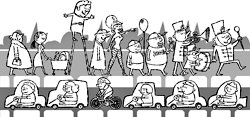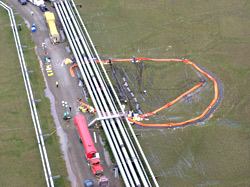In the great tradition of Frederick Law Olmsted—architect of America’s most famous city parks—state planners have conceived their own 21st-century urban utopia: a vast parkway slicing across the skyline, with sweeping views of Puget Sound and downtown Seattle.
Imagine chubby boys moping about as their dads try to get them to kick a soccer ball, designer dogs dashing after Frisbees, teenagers swapping spit, bums dozing on benches—everybody doing their thing at a staggering six stories above the ocean blue.
This grand vision is part of one state- financed proposal to replace the Alaskan Way Viaduct with a new, improved elevated highway. Instead of a two-deck road, however, only the lower level would carry cars (on a whopping six-lane highway). The upper deck would contain the park, a greenbelt stretching more than 100 feet wide and up to three-quarters of a mile long.
But wait, there’s more.
Concerned about noise from all those cars zooming along state Route 99 below the park, state transportation planners have also proposed a series of garage doors that would enclose the highway during peak traffic hours. The doors would roll down and the highway, in effect, would become a floating tunnel. Meantime, sunset strollers and families alike would frolic in the elevated Eden lurking directly above the rush-hour grind.
The state Department of Transportation came up with the parkway proposal earlier this year, one of several alternatives under consideration should Gov. Christine Gregoire decide to scrap the city’s preferred plan to replace the Alaskan Way Viaduct with a cut-and-cover tunnel. She expects to make a decision by January. Other above-ground options proposed by DOT include elevated, side-by-side roadways, another double-decker highway, and a cable bridge with 14-story-tall towers.
None has gotten much attention in Seattle, perhaps because city brass is so in love with its tunnel concept, which would create open space along the waterfront but cost up to $5.5 billion. In early August, Ron Paananen, DOT’s viaduct project director, presented the above-ground alternatives to the Seattle City Council. He said his team whipped together the plans when it became apparent earlier this year that the financially challenged tunnel may not happen.
As Paananen described the park viaduct, some council members smirked. “How are people going to get to this park?” one asked. Skyways could be built between the park and adjacent buildings, Paananen replied—that is, if the building owners were willing to provide access. Or maybe there could be stairs and elevators.
Either way, Paananen now concedes the park option “is probably a dead horse at this point.” But it’s not that the idea itself is bad—it’s money. While his team is still crunching numbers, it appears that placing a “park lid” on an elevated highway would be cost-prohibitive. The latest estimate pegs a new elevated viaduct similar to the existing one (along with a seawall and other improvements) at about $2.8 billion. The park-highway viaduct would well exceed that price tag, Paananen estimates.
We atSeattle Weekly are dismayed to hear that the state is backing down. A park in the sky could be our generation’s Space Needle—a marvel of our times, a great leap into the future, a municipal icon. The city waterfront would become an afterthought as Seattleites took to the air. So inspired are we by an elevated park that we hired our own team of architects and engineers (or, at least, scribes in sheep’s clothing) to expand the idea.
When commenting on his design for New York’s Central Park, Olmsted said: “It should have an aspect of spaciousness and tranquility.” We agree with that philosophy, but we also believe a park should be an experience in democracy, which is why ours would offer something for everybody.
Hence, our new Alaskan Way Viaduct park would be topped off with trees, trails, and ponds (stocked with salmon, of course); volleyball courts and soccer fields; a small train for children; and even a ski hill—not to mention an all-important tetherball court and enough room for UW’s Husky Paintball Club to shoot each other up. The state’s current design calls for the park to hover about 60 feet off the ground. We’d like to see the height tripled. Bungee jumpers would dig it, and human cannonballs would need the extra vertical to safely clear the waterfront.
We’d also include a helicopter pad, where nubile lap dancers, fire-eaters, mimes, men on stilts, and the like would descend on the park before gracing the stage of a Greek-style amphitheater. The rest of us could ride the monorail to the greenbelt, for which there would be a link. Finally, when you’d had your fill for the day, you could dive down a spiral water slide to the sidewalks below.
Now, you ask, how would we pay for it?
The answer lies in those retractable doors that swing down along the highway during heavy traffic. State planners thought it would be nice to decorate them so that when they’re closed, passersby could gawk at artful designs.
We propose turning the doors into billboards. Just think how much you could make off a garage-size Starbucks ad. Hundreds of these doors would line the viaduct—the project would pay for itself. And the lap dancers would grind for free.






